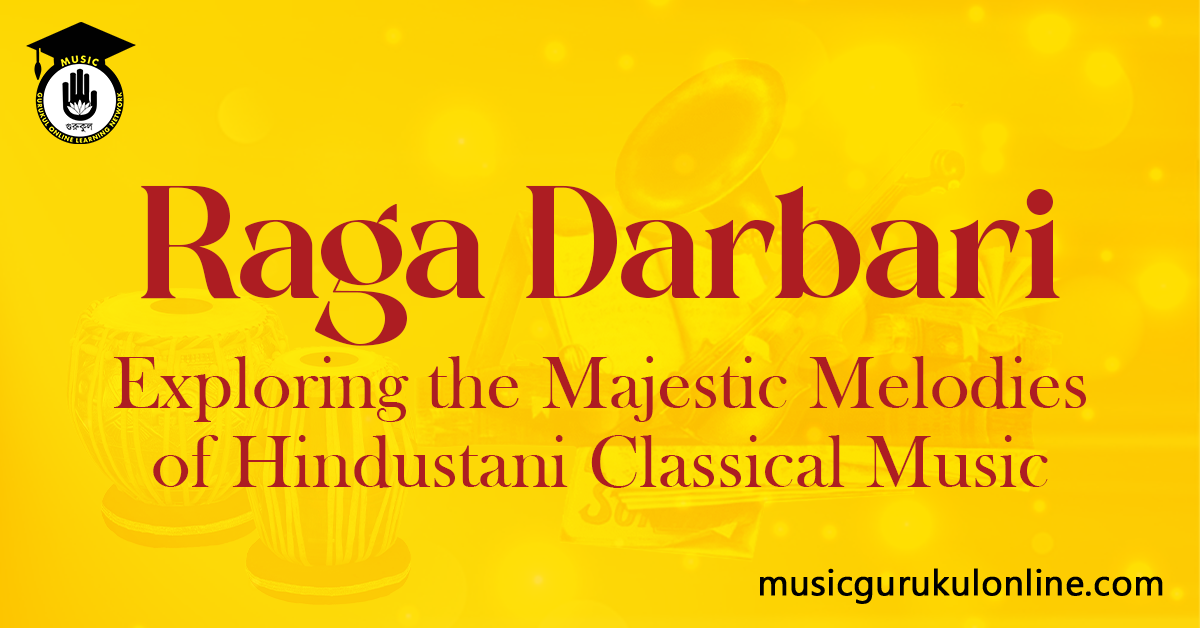Raga Darbari Kanada, or simply Raga Darbari, (pronounced darbāri kānada), is a raga in the Kanada family. Hindustani classical music, a rich and intricate tradition, is known for its profound melodies and intricate improvisations. Among the many ragas that adorn this musical landscape, Raga Darbari holds a special place of prominence and intrigue. With its deep, contemplative nature and majestic character, Raga Darbari has captivated musicians and listeners for centuries, leaving an indelible mark on the world of Indian classical music.
Table of Contents
Raga Darbari

Origin and Historical Significance:
Raga Darbari is believed to have originated from the dhrupad style of music, which flourished in the medieval courts of North India. Its name derives from the word “darbar,” meaning royal court, alluding to its regal and dignified essence. While the exact origins of Raga Darbari remain elusive, its influence can be traced back to the medieval period and the reign of Emperor Akbar in the Mughal Empire.
Legend has it that Tansen, the legendary court musician of Emperor Akbar, had the ability to evoke rain through his rendition of Raga Megh Malhar. However, when he performed Raga Darbari, his music was so powerful and deeply moving that it caused the lamps to be extinguished and darkness to envelop the entire court. This legendary incident highlights the immense emotional depth and gravity associated with Raga Darbari.
![Raga Darbari: Exploring the Majestic Melodies of Hindustani Classical Music 3 Raga Darbari: Exploring the Majestic Melodies of Hindustani Classical Music Indian Classical Music, Hindustani & Carnatic [ ভারতীয় শাস্ত্রীয় সঙ্গীত, হিন্দুস্থানি ও কার্নাটিক ]](https://musicgurukulonline.com/wp-content/uploads/2022/01/Indian-Classical-Music-Drawing-42-300x300.jpg)
Characteristics and Structure:
Raga Darbari belongs to the Kafi thaat, which is one of the ten fundamental scales in Hindustani classical music. It is primarily performed during the late-night hours, specifically in the second quarter of the night. This timing is thought to enhance the introspective and meditative nature of the raga.
The raga is characterized by the use of flat (komal) Re (minor second) and Dha (minor sixth), along with the natural (shuddha) notes of the scale. The flat second imparts a distinct melancholic quality to the raga, while the flat sixth lends a touch of mystery and longing. The komal Ni (flat seventh) is also often used, further intensifying the emotional impact of the raga.
![Raga Darbari: Exploring the Majestic Melodies of Hindustani Classical Music 4 Raga Darbari: Exploring the Majestic Melodies of Hindustani Classical Music Indian Classical Music, Hindustani & Carnatic [ ভারতীয় শাস্ত্রীয় সঙ্গীত, হিন্দুস্থানি ও কার্নাটিক ]](https://musicgurukulonline.com/wp-content/uploads/2022/01/Indian-Classical-Music-Drawing-38-239x300.jpg)
Darbari’s melodic structure offers a wide scope for improvisation, allowing the performer to explore various intricate phrases and meandering patterns. It is considered an audav-sampurna raga, meaning it uses five notes in the ascending (Aroha) scale and all seven notes in the descending (Avroha) scale. The scale for Raga Darbari can be represented as follows:
Aroha: Sa Re Ga Ma Pa Dha Ni Sa
Avroha: Sa Ni Dha Pa Ma Ga Re Sa
In addition to the basic notes, artists often embellish the raga with grace notes, microtonal inflections, and characteristic phrases, adding further depth and expression to their renditions.
Emotional and Expressive Range:
Raga Darbari is renowned for its ability to evoke a spectrum of emotions, ranging from profound introspection and contemplation to feelings of melancholy and yearning. It captures the essence of introspective solitude, making it a preferred choice for late-night performances. The haunting beauty of the raga lies in its ability to create a deeply immersive and emotional experience for both the performer and the listener.
![Raga Darbari: Exploring the Majestic Melodies of Hindustani Classical Music 5 Raga Darbari: Exploring the Majestic Melodies of Hindustani Classical Music Indian Classical Music, Hindustani & Carnatic [ ভারতীয় শাস্ত্রীয় সঙ্গীত, হিন্দুস্থানি ও কার্নাটিক ]](https://musicgurukulonline.com/wp-content/uploads/2022/01/Indian-Classical-Music-Drawing-35.jpg)
The alap, the unhurried and meditative introduction to the raga, sets the mood and allows the artist to explore the raga’s contours and expressions. As the performance progresses, the artist weaves intricate melodic patterns, gradually building tension and complexity. The composition (bandish) that follows the alap serves as a structured framework within which the artist can further elaborate and showcase their improvisational skills. The interplay of melodic phrases, rhythmic cycles, and subtle ornamentations creates a tapestry of sound that is both captivating and emotionally charged.
Evolution and Influence:
Over the centuries, Raga Darbari has evolved and found its expression in various forms of Hindustani classical music. It has been a favorite of eminent musicians and composers, who have explored and reinterpreted its melodic nuances. Prominent artists such as Ustad Amir Khan, Ustad Abdul Karim Khan, Pandit Mallikarjun Mansur, and Ustad Bade Ghulam Ali Khan are among those who have left an indelible mark on the raga through their unique interpretations.
Beyond Hindustani classical music, Raga Darbari has transcended cultural boundaries and influenced diverse musical genres. Its melancholic allure and melodic richness have inspired composers in the realms of Indian film music, ghazals, and fusion music. The raga’s universal appeal lies in its ability to convey deep human emotions and touch the soul of the listener, regardless of their cultural background.
![Raga Darbari: Exploring the Majestic Melodies of Hindustani Classical Music 6 Raga Darbari: Exploring the Majestic Melodies of Hindustani Classical Music Indian Classical Music, Hindustani & Carnatic [ ভারতীয় শাস্ত্রীয় সঙ্গীত, হিন্দুস্থানি ও কার্নাটিক ]](https://musicgurukulonline.com/wp-content/uploads/2022/01/Indian-Classical-Music-Drawing-33.jpg)
Raga Darbari, with its grandeur and emotive power, exemplifies the essence of Hindustani classical music. Its evocative melodies and profound expressions have fascinated and moved audiences for centuries. As musicians continue to explore and innovate within the tradition, Raga Darbari will undoubtedly continue to inspire and enchant generations to come, leaving an enduring legacy in the world of Indian classical music.
